How much longer do we have to keep all this fake meat in the fridge?” my wife yells from the kitchen.
Over the past few days, I have stockpiled a hunk of Impossible Foods ground beef the size of a mailbox, six packages of Beyond Meat burger patties, several towers of Beyond Sausage in various flavors, and four pouches of Good Catch tuna.
I wasn’t sure if she had peered into the freezer yet, but there she’d find stacks of Beyond Sausage breakfast patties lurking in a shady-looking unmarked plastic bag.
I’m a lifelong meat eater who dabbles in vegetarianism, tries not to screw up the environment, and is naturally curious about all these new plant-based packaged protein products aimed at conscientious carnivores.
My wife, however, is skeptical. A good grass-fed steak from our local butcher doesn’t need flashy packaging or buzzwords to sell itself, she argues. My daughter, seven, and son, five, are even more leery. Their usual diet consists of hot dogs, burgers (the meat kind), and buttered pasta.
I’ve taken all their points into consideration, but aren’t things different now? Impossible Burgers are meaty patties that “bleed”! Beyond Sausages are hearty enough to grill! Plus, there’s the whole issue of Big Beef, Big Chicken, and Big Pork gobbling up land, energy, and cheap labor to raise and process traditional meat.
With plant-based proteins now infiltrating everything from Whole Foods to White Castle, why shouldn’t we at least indulge our curiosity?
Okay, my curiosity.

.
Experiment #1: Impossible Beef and Beyond Burgers
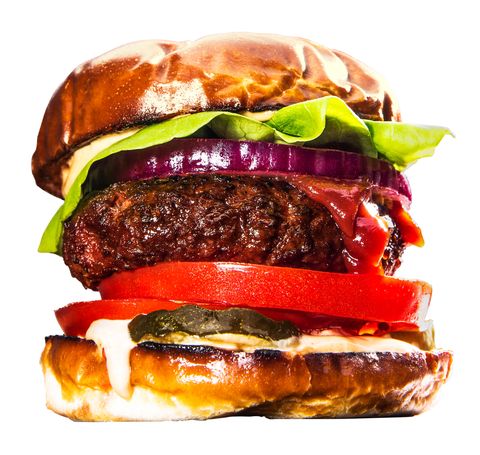
Men’s Health
The first thing I noticed was how, even in prep work, Impossible Foods’ beef resembled the real thing. To mimic the look and flavor of animal blood, Impossible uses soy leghemoglobin, a substance so viscous that it requires a thorough hand scrubbing to keep me from appearing like a horror-movie victim.
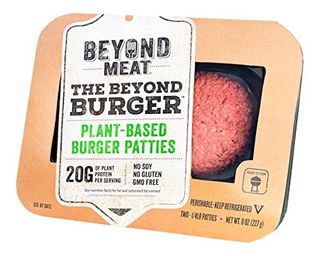
Beyond Meat, The Beyond Burger, 0.5 lb
Beyond Meat
amazon.com
SHOP NOW
I cooked the patties as I would any other: hot cast-iron pan, a pour of olive oil, a few minutes on each side. I couldn’t believe the beef-like char. I slid the juicy patties onto rolls and served them. And then something amazing happened. My kids gobbled down their burgers.
Encouraged, I dressed my own burger with cheese, lettuce, tomato, and a mixture of mayo, ketchup, and relish. Impossible didn’t rival my all-time favorites, but it instantly replaced all my bad memories of veggie burgers.
Now, Beyond Burgers are a different story. You can find these patties at Target for about six dollars for a two-pack.
They’re pea-protein-based, not soy-based, and don’t contain soy leghemoglobin. Beyond does mimic the taste, texture, and juiciness of a beef burger effectively, but I found that it had an aftertaste that killed off the good vibes you get from saving a few cows.

.
Experiment #2: Beyond Sausages
For as much attention as soy-based burger patties have received, I’m surprised more people haven’t caught on to the world of pseudo sausage.
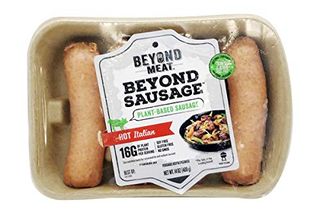
Hot Italian Plant-based Sausage
Beyond Meat
SHOP NOW
Beyond’s bratwurst and hot Italian sausage have been on the market less than two years, and I’m now sold on the fact that their flavor, texture, and versatility outperform those of any of the alt-burgers.
I’ve grilled Beyond hot sausage and eaten the snappy links with peppers and onions on Italian bread. I’ve cooked it, chopped it into quarter-sized bites, and mixed it with cavatelli, brown butter, and sage. Amazing.
And then there’s Beyond’s new breakfast sausage patty, which will soon be in your freezer aisle. Granted, much of the flavor of any sausage comes from the spices, but there’s also something satisfying about the texture.
The brats have a pop similar to those made with animal casings, even though Beyond’s offerings are made with algae. The breakfast sausage has that fork-cutting meatiness found in ground pork, which the company credits to a mixture of peas, fava beans, and rice.
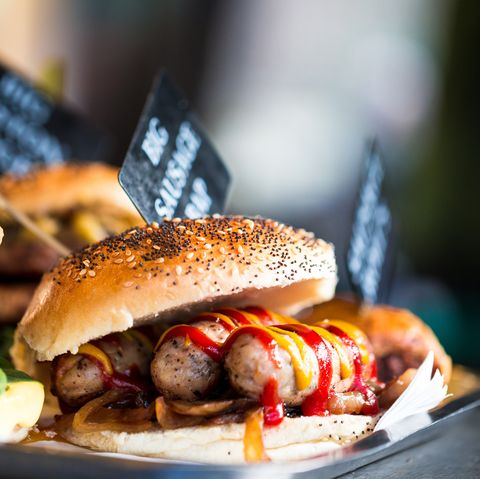
coldsnowstorm
I told none of this to my wife and kids, however, who went on to sample this faux sausage with pancakes, eggs, and French toast. I even watched them gleefully dip their patties into maple syrup.
Divulging the truth to them would only spoil the fun.

.
Experiment #3: Good Catch “Tuna”
At this point, a few weeks in, I had accepted plant-based burgers and sausage into my diet. My wife, perhaps buoyed by the dwindling supply of fauxtein in the fridge or maybe surprisingly delighted by the fake sausage after I told her what it was, seemed to be more open-minded.
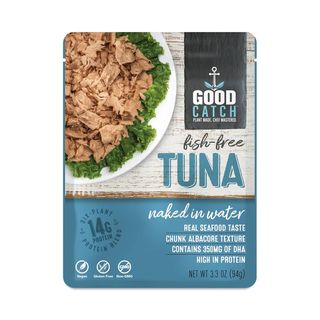
Fish-Free Tuna Naked In Water
Good Catch
thrivemarket.com
$3.14
SHOP NOW
My children no longer thought Daddy was “really weird” (at least not within the parameters of this research). Now it was time for me to go deep. I was ready to try Good Catch’s approximation of albacore tuna. A good tuna melt is one of my top comfort foods, so I was eager to see if Good Catch’s six-legume blend could satisfy.
I mixed the faux tuna with my usual recipe of mayonnaise, Dijon mustard, capers, and celery. I tasted it for seasoning. Not bad. Then I loaded two scoops onto wheat toast followed by slices of sharp cheddar. Under the broiler, the melting cheese blanketed the “tuna” and bubbled.
The results: Though it had a slightly mushier, looser consistency than real tuna, it tasted cleaner and less fishy. Even under the heat of the broiler, the “seafood” held up.
This particular experiment had a sample size of one. Try as I might, I couldn’t convince my family to partake in a Good Catch tuna melt.
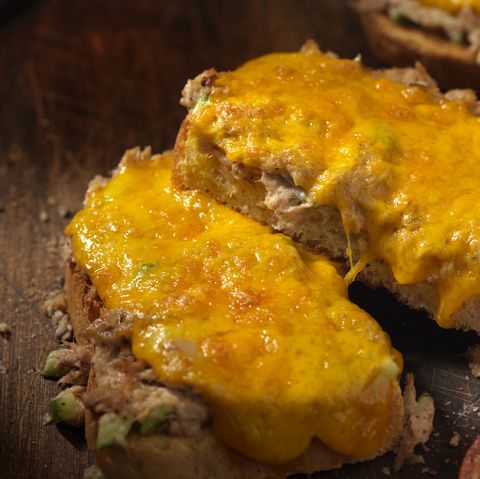
Lauri Patterson
I also couldn’t sell them on a nutrition angle, because I wasn’t even sure if any of this plant-based protein was, in fact, actually good for us.

.
Analysis: Is Fake Meat Even Healthy?
Ryan D. Andrews, R.D., a Connecticut plant-based-nutrition expert and author of A Guide to Plant Based Eating, is reluctant to champion meat alternatives.
“These kinds of meat analogs are recent inventions,” he says. “We don’t know the long-term health repercussions of regularly consuming them.”
The category of fauxteins is still too new to have a body of dietary intervention research reflecting a positive or negative effect on health.
“The average American is eating about seven ounces of meat per day. If this American were to do a straight swap and start eating seven ounces of meat analogs per day, with everything else in the diet being held constant, it’s hard to say for sure if this would offer much of a health benefit,” Andrews says.

Hero Images
Others in the nutrition world see an expanded definition of “protein” as beneficial. “Ten years ago, if someone wanted to be vegan, they didn’t have a lot of choices,” says Abby Langer, a Toronto-based dietitian.
“They had tofu, maybe they had tempeh. It’s allowing people to eat more plant-based diets than ever before by giving people a choice and increasing access. That’s a good thing.”

.
Conclusion: More Research Is Needed
I’m not really into fast food, but I tried White Castle’s Impossible Sliders and they’re actually better with fake meat—less greasy and a bit cleaner tasting.
Even though meatless patties are also selling well at Burger King and Red Robin, and other national chains may follow suit, I believe that the success of fauxteins resides within the world of home cooking.
For the first time in what seems like a long time, people like me are not only curious about eating more plants, they’re excited. What I didn’t expect from all this experimental “meat” was that I’d actually relish the experimentation.
Don’t tell my wife, but there are a few more plant-based proteins on the way to our home. I just have to find some more room in the fridge.
Source: Read Full Article
